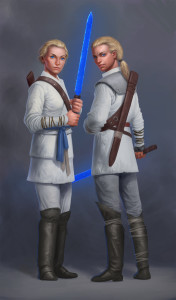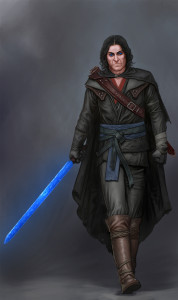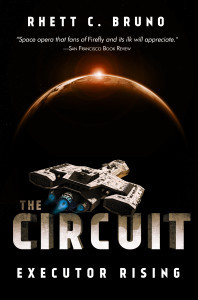Christopher Kellen's Blog
November 9, 2016
DESTINY Update
Wow, it’s been a while. I’ve been hard at work on a variety of things, but today I’d like to share a short excerpt from DESTINY, the fourth and final volume of the ARBITER CODEX:
===========================
“Run,” Moncrief managed to wheeze. “Run!”
Everything moved like molasses. The Arbiter seemed to stare, dumbfounded, as the talons came down and crashed into him, catapulting D’Arden backward through the door of the chamber and out into the hallway. He hit the opposite wall with a sickening thud.
Moncrief fell backward toward the door, scrambling desperately away with his hands and feet. The creature lunged toward him just as he passed through the doorway–he grabbed the heavy oak door with both hands and slammed it shut as the inky claws collided with it.
A terrible scratching sound filled the corridor. Moncrief pulled himself to the fallen Arbiter’s side, where D’Arden lay nearly senseless, fetched up against another door frame and bleeding lightly from a wound on his skull.
“That’s not going to hold,” the sorcerer whispered breathlessly, casting a terrified glance at the door behind him. “Come on, come on, we have to run!”
He dragged the Arbiter to his feet, and the two of them stumbled down the corridor, away from the chamber, away from hope, away from Sabin.
“Where?” the Arbiter asked, his voice dull and confused.
Moncrief thought frantically. His mind seemed to be roiling at several times its normal speed, but with none of its usual organization. In the end, though, all of his thoughts boiled down to a single question.
Is there anywhere safe from that thing?
November 17, 2015
Elisa Shannari – The Apprentice
The amazing Tony Warne has given us the next installment of this 3-piece artwork series highlighting some of the most important characters of The Arbiter Codex.
Ladies and gentlemen–Elisa Shannari (ELEGY, left and CLARITY, right).
November 3, 2015
D’Arden Tal — The Arbiter
I am currently working with the artist (Tony Warne, aka jedi_art_trick) who produced the Edar Moncrief artwork which stars on the cover of The Elements of Sorcery (you have to look closely!) to produce concept art for some of the principle characters in The Arbiter Codex.
Today, I give you D’Arden Tal.
July 1, 2015
This Long Vigil: A Short Fiction Review
 My fellow author Rhett C. Bruno (author of The Circuit: Executor Rising, a book I read and quite enjoyed last August) pointed me toward a new story he had published by Perihelion Science Fiction in June.
My fellow author Rhett C. Bruno (author of The Circuit: Executor Rising, a book I read and quite enjoyed last August) pointed me toward a new story he had published by Perihelion Science Fiction in June.
This Long Vigil is perhaps a story we know, or perhaps one that, as lovers of sci-fi, we may have considered in our own minds. A generation ship hurtles through the blackness of space, its inhabitants dwelling in a deep cryogenic sleep, tended by just one of their number–Orion–who must ensure that everything stays running. Orion’s only companion is the ship’s AI, known as Dan, a disembodied voice of reason and riddles.
This is a story of loneliness and longing, of human nature and the choice between duty and freedom. Its themes strike close to home, and the prose carries the reader effortlessly through sentence and paragraph, until its final, bittersweet conclusion which is, if not totally unexpected, the natural conclusion to the feelings and themes which well up and overflow in celebration of its greatest theme: the human desire for self-determination and freedom.
A quiet, soft-spoken yet thoughtful story, This Long Vigil is available free at Perihelion Science Fiction, and is highly recommended.
May 27, 2015
The Circuit: Executor Rising
[This post was originally located on The Genre Underground. I read the book during my trip to London in August, 2014. Mr. Bruno has just re-released the book with a new publisher, and I wanted to make sure that people know about it!]
Full Disclosure : I was provided a copy of this book in exchange for an honest review. I do not know the author personally, except for our brief interactions by email.
The Circuit : Executor Rising is a fast-paced and enjoyable science fiction yarn that takes place in a most interesting setting. It’s our own solar system, either during a time before interstellar travel becomes possible, or perhaps in a universe where the laws of physics never become more than what we know now. Regardless, Mr. Bruno does a great job showing us how our own tiny, insignificant star system can feel like a vast and wondrous place.
The story follows several principal characters : Sage is a young, deadly assassin known as an Executor ; a hard-working miner named Talon ; and perhaps most intriguingly, a disaffected scientist and former member of the system’s ruling council, Cassius Vale. Vale, and by extension, his AI creation known as ADIM, are definitely the antagonists in this story… Villains, even. And yet they are, by far, the most fascinating and sympathetic characters in the book. It takes a lot of storytelling talent to make a monomaniacal mad scientist feel like a real person, justified in his horrific actions to the point where you root for him, instead of those trying to stop him.
By and large, the plot is not something which will surprise a veteran science fiction reader, but rather serves as a showcase for Mr. Bruno’s adept worldbuilding and strong characterization. He gives us things to be genuinely interested by and characters we can believe in within the space of a few hundred pages, making for a thoroughly enjoyable read.
With no major editorial issues to speak of and pages that kept me coming back for more, The Circuit : Executor Rising earns 4.5 out of 5 stars. As is my standard policy, I will round this up to 5 stars on the appropriate websites.
Publisher | Amazon | Barnes & Noble | Kobo | iBooks
March 23, 2015
Musings: Quantum Immortality
Originally posted by me on io9.com in response to this article:
See, to me, quantum immortality looked pretty neat at first. Oh hey, if there’s always a chance, no matter how small, that I won’t die—then I won’t. Ever. Cool, right?
Except that you slowly realize that in this scenario, your consciousness (and by extension, the consciousness of every other being… ever?) continues on indefinitely. No matter how old and impossibly frail your body grows, you remain alive. Universes peel off around you in droves like the layers of an onion. Your friends and loved ones all die as the probability of them surviving decreases (because the probability that you and any other given person survive forever together is just slightly less than the one that allows you to survive alone, even though that possibility must also exist somewhere in the multiverse) but because you are always on the track where you survive (because otherwise you cease to exist)… you do.
Somewhere out there in an infinite multiverse of infinite probabilities, you are celebrated as the oldest person alive. Eventually, everyone who remembers that dies, and yet you continue on. Eternally. Until at last, you are the single living creature to witness the heat death of your universe, billions of years hence, somehow, some way, still alive—because in infinity, this possibility must exist.
And this has happened for every other conscious being which has ever existed or will ever exist in the multiverse.
And that’s how the many worlds interpretation becomes existential horror.
Fin.
October 16, 2014
CLARITY
At just over 55,000 words and more than nine months of work (not counting previous, failed attempts at Arbiter Codex Book 3), the first draft of CLARITY is complete.
With luck, it will be revised and released by year-end.
October 10, 2014
Does Thinking Critically Make You A Psychopath?
The answer may seem obvious. In case you’re wondering, the answer is:
No.
On another outlet, a person asserted that rational and critical thinking is akin to thinking like a psycho- or sociopath. They then proceeded to make “scare quotes” from other articles (i.e. picking particularly chilling passages about documented psychopaths) in an attempt to emotionally manipulate anyone who might read their “contribution” into agreeing with their premise, or otherwise be equated with psychopathy.
This has quietly enraged me.
Below is the majority of my reply to this person, because I fear that this is something that people actually think, and this scares the ever-living Jeebus out of me.
The point of critical thinking skills is not to BECOME anything. The point is to cause each individual person to weigh ALL of the evidence that impacts them, to be curious enough to investigate what they don’t understand, until THEY are permitted to come to the conclusion which THEY believe suits the evidence. That’s it.
Real indoctrination comes from people who do not permit evidence to be counted because it goes against their dogma. Every human being is susceptible to this, from religious types to scientists, because we all like our worlds to be explainable and reliable, and as human beings, we don’t like things that challenge what we “know” to be true. We tend to fight against those things by making unfavorable comparisons (like, say, equating critical thinking to being a psychopath) or otherwise degrading them, laughing at them, or even pretending they don’t exist. All of these things are failures of critical thinking.
Considering a wide variety of evidence from agreeing and conflicting viewpoints and coming to a conclusion, whatever that conclusion is, is not “thinking like a psychopath”. A psychopath, as evidenced by the entirety of the article you linked to (which is a good read, by the way, even if you insist on cherry-picking pieces of it to support your flawed conclusion) is narcissistic, tends toward the obsessive, and is sometimes to be considered ‘hyper-rational’ because they lack some of the emotional capability of a neurotypical individual. While it’s true that proponents of ‘rationality’ argue against the use of emotions within a decision, there’s a reason for that: emotions tend to cause us to disregard evidence that we don’t agree with before giving it a fair shake. However, the fact remains that for a neurotypical individual, emotions are part and parcel of the human experience, and internal emotional evidence MUST be weighed as part of the evidence in coming to a conclusion. How much weight an individual gives to those emotions will depend on that individual, particularly in the strength of their meta-cognition.
Rationality and critical thinking are not ways of thinking—they are ways of thinking ABOUT thinking, methods for understanding ourselves and the world around us. You do yourself and everyone who reads what you write a disservice by making false and specious comparisons.
July 16, 2014
The Arbiter’s Tower Has Stairs…
…lots of stairs.
—-FROM CLARITY, Book 3 of the Arbiter Codex, Chapter XIV—-
“More bloody stairs,” he muttered under his breath as he shuffled upward. “Who designed this place, anyway? Some sadistic, cackling madman with a crystal sword, I’m sure. ‘Build more stairs, hither and yon, and climb them all!’ he’d cry, and all the little underlings would weep, because no one wanted to clamber up just one more black-gods-blasted—“
March 12, 2014
CLARITY Snippet
My current project is CLARITY: Book Three of the Arbiter Codex. Here’s a little snippet from Chapter 2. Previous books have used D’Arden Tal and Elisa Shannari as point-of-view characters–book three will feature a new POV.
“[He] still held out some hope that he might stumble across a useful book, secreted away in some dusty corner, but it had slowly transformed from a burning beacon of passion and motivation into a dwindling candle flame of cynicism and disdain. With each passing day it dripped more metaphorical wax into a sad and lonely pool at its base, and soon would snuff out entirely.”






